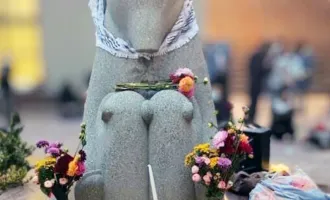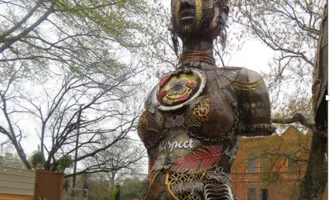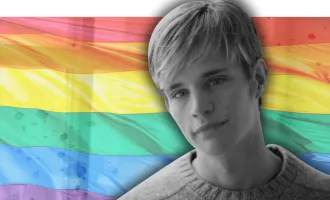
Increasing Awareness at UCSF
“How do you make a movement sustainable with drastic change?”
Sidra Bonner is a third-year medical student, and she and other UCSF medical students shook the foundations of academic medicine last year with the December 2014 Die-In, a protest which evolved into the national White Coats 4 Black Lives (WC4BL) movement. WC4BL, whose vision is “to safeguard the lives and well-being of our patients through the elimination of racism,” is part of a broader national focus on racism and structural violence.
For Bonner, however, sometimes medical school gets in the way.
“You get here, and you’re like, ‘We’re going to change everything!’ And then you get to third year.”
The third year of medical school, where students start their clinical education, is notoriously difficult and time-consuming. For Bonner, entering these years as a leader in a social justice movement has been equally eye-opening and trying. She has had to manage both involvement in activism and attention to her grades, a balancing act made more important because of a widely-held double standard for minority students speaking out.
“For students of color, the message can get diluted if you’re not academically sound.”
Bonner and other WC4BL leaders find themselves in a predicament unique to medical school; how do you affect institutional and structural change when the movement leadership has to change every year?
Bonner cited the lack of “institutional memory” as a new challenge to WC4BL, as many of the leaders are soon to enter their third and fourth year. At the same time, she feels the continued importance of the movement every day during her clinical rotations.
“It’s the first time that you feel the hierarchy of medicine,” Bonner said, describing inappropriate behavior she’s experienced by higher-ups, and how she feels conflicted in confronting it, due to the completely subjective nature of the clinical evaluations.
She also sees the work that needs to be done through the mistreatment and disparities in care of her patients. “You feel the burden of being a minority. You see a lot of things that you’re fighting against.”Second-year medical student Andrea Quiñones-Rivera feels that same burden. When she was accepted to medical school, she was excited to just be a student again; the start of the movement changed that.
She sees WC4BL as something necessary, something she feels compelled to do, because the medical community does not recognize violence and racism as health care issues. At the same time, she and all the other WC4BL leaders are full-time medical students.
“We’re like, we have to do this, but… we have to study,” said Quiñones-Rivera. She notes that, though investing themselves in WC4BL, student leaders “sacrifice. We sacrifice time and education.”
Quiñones-Rivera currently acts as the WC4BL liaison to the UCSF administration, a duty that she takes seriously, and one that she finds risky. With an eye on her long-term goals of being a physician, a leader, and advocate for her patients, she is careful to not unduly upset the powers-that-be.
On the whole, Quiñones-Rivera says, the UCSF administration has been very open to criticism and advice. Though noting that it’s not enough, she admits that “when I think about the progress we’ve made, it’s amazing.” Administrative progress is slow, she said.“No one has done these things before in medicine.”
For her own self, however, Quiñones-Rivera says that this work takes a toll. “It’s hard [for the administration] to realize what sacrifices we make as students.”
Fellow second-years Kafi Hemphill and Walker Keenan both took part in the Die-In in 2014, and were leaders in the most recent demonstration, #actionsspeaklouder, this past December.
Hemphill sees her imminent entrance into third year and her professional career as an opportunity to effect change on a larger level; she believes real change will happen when she and her fellow activists become the people in power. “In the future, it’s a different kind of activism,” Hemphill said.
She believes that the current generation of medical leaders are ignorant of what is important to patients and students of color, and that only by attaining that level of leadership can she and fellow students start to reverse generations of racism and systemic violence in medicine.
The demonstrations were big and eye-catching, and served the dual purpose of attracting attention and helping students express their grief and anger.
However, said Hemphill, “the major changes are happening behind the scenes.”
That is not to say that the transition to the new generation of student leaders isn’t hard. For Keenan, who has been very involved in the national movement, racism and minority violence is a public health problem, one which he wants to structure his medical career around.
Though determined to stay involved in the movement, possibly in his fourth year, Keenan is getting ready to turn over much of his responsibilities to first-year medical students. He hopes to be a leader in academic medicine, and perhaps work as a forensic psychiatrist in a prison system that is disproportionately racialized. For right now, he’s turning his focus to boards.
“I need 110% of my cognitive focus on school,” said Keenan, though noting that he will continue to work for WC4BL as much as possible.
The new leaders of WC4BL are currently planning what their contribution to the movement will be (look forward an upcoming Synapse report on this). For more senior leaders like Sidra Bonner, the movement and the struggle for social justice and equity for themselves and their patients continue, but in a new form.
“The third year is less about short-term goals. It’s what are your long-term goals; who do you want to be?”


